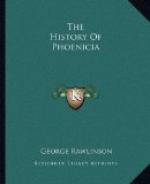the grinning
ex-votos which hung upon the walls,
and the curious pictures with which they were accompanied.
Grotesque bas-reliefs adorned the circuit of the edifice,
where the slanting light was reflected from the white
and polished pavement-stones."[638] In length and
breadth the chamber measured sixty feet by thirty;
the thickness of the basement wall was three feet.[639]
Midway between the side walls stood three rows of large
square pedestals—regularly spaced, and
dividing the interior into four vistas or avenues,
which some critics regard as bases for statues, and
some as supports for the pillars which sustained the
roof.[640] Two stone capitals of pillars were found
within the area of the chamber; and it is conjectured
that the entire disappearance of the shafts may be
accounted for by their having been of wood,[641] the
employment of wooden shafts with stone bases and capitals
being common in Cyprus at the present time.[642] Against
each of the four walls was a row of pedestals touching
each other, which had certainly been bases for statues,
since the statues were found lying, mostly broken,
in front of them. The figures varied greatly
in size, some being colossal, others mere statuettes.
Most probably all were votive offerings, presented
by those who imagined that they had been helped by
the god of the temple to which the chamber belonged,
as an indication of their gratitude. The number
of pedestals found along one of the walls was seventy-two,[643]
and the original number must have been at least three
times as great.
Another Cyprian temple, situated at Curium, not far
from Paphos, contained a very remarkable crypt, which
appears to have been used as a treasure-house.[644]
It was entered by means of a flight of steps which
conducted to a low and narrow passage cut in the rock,
and giving access to a set of three similar semi-circular
chambers, excavated side by side, and separated one
from another by doors. Beyond the third of these,
and at right angles to it, was a fourth somewhat smaller
chamber, which gave upon a second passage that it
was found impossible to explore.[645] The three principal
chambers were fourteen feet six inches in height,
twenty-three feet long, and twenty-one feet broad.
The fourth was a little smaller,[646] and shaped somewhat
irregularly. All contained plate and jewels of
extraordinary richness, and often of rare workmanship.
“The treasure found,” says M. Perrot, “surpassed
all expectation, and even all hope. Never had
such a discovery been made of such a collection of
precious articles, where the material was of the richest,
and the specimens of different styles most curious.
There were many bracelets of massive gold, and among
them two which weighed a pound apiece, and several
others of a weight not much short of this. Gold
was met with in profusion under all manner of forms—finger-rings,
ear-rings, amulets, flasks, small bottles, hair-pins,
heavy necklaces. Silver was found in even greater




